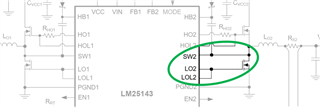Hello,
my question is on the max rating of SW1/2 of LM25143-Q1. Currently they are specified with -0.3V.
Wouldn't this be an issue, in case LOL1/2 gets open?

Thanks and best regards,
Michael
This thread has been locked.
If you have a related question, please click the "Ask a related question" button in the top right corner. The newly created question will be automatically linked to this question.
Hello,
my question is on the max rating of SW1/2 of LM25143-Q1. Currently they are specified with -0.3V.
Wouldn't this be an issue, in case LOL1/2 gets open?

Thanks and best regards,
Michael
Hi Michael,
That is really a DC voltage spec.
We have a spec of -5V transient on SW for ~20ns.
We expect SW to go to a diode voltage during the deadtime when LO is off, yes.
-Orlando
Hello Orlando,
thanks for the answer. This is somehow helpful already. I have two more questions:
Can a series resistance be connected to SW pin like shown below and how does this effect the diode emulation mode?
Can a series resistance be connected to LO2 and if yes, what is the max resistance?

Thanks and best regards,
Michael
Michael,
Series resistance for SW will function similar to boot-resistor or HOL resistor, it will slow down SW node fall time (better EMI but lower efficiency). It will also slow down boot capacitor charging.
It should not affect diode emulation much.
Series resistance for LO is OK, but not really beneficial.
Resistance on LOL is not recommended due to potential for parasitic self-turn-on of the low-side FET.
Hope this helps,
-Orlando
Hi Orlanda,
have you tested a resistor on LO? What would be the maximum allowed resistance possible?
Thanks,
Michael
Hi Michael,
Not usually, we don't test with LO gate resistance.
LO resistance will just slow down Low-side FET turn-on time.
This is usually negligible, because before LO turns on, SW is ~-0.7V for the body diode conduction during the deadtime.
Therefore SW on transitions from ~-0.7V to ~0V, which is not significant.
You can maybe model the rise time with 5V source charging a RC, where R is gate resistor and C is CISS of MOSFET selected.
-Orlando